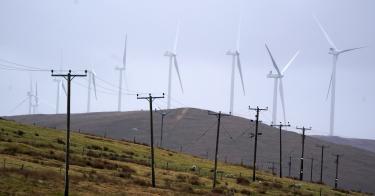At last year’s U.N. climate conference in Dubai, the Biden administration agreed to triple the world’s renewable-energy capacity by 2030. It also joined the Powering Past Coal Alliance, pledging to eliminate coal-powered generation. This is all part of President Biden’s goal to completely decarbonize the U.S. electrical grid by 2035 and achieve net-zero greenhouse-gas emissions by 2050.
Britain has been going down this path since 2008, when Parliament wrote an 80 percent decarbonization target into law, which it raised to 100 percent, or net zero, in 2019. This luxury net-zero policy, which only the rich can afford, has been devastating for both businesses and ordinary Britons just trying to heat their homes and get to work.
A new report for the RealClear Foundation by Rupert Darwall is a timely and much-needed warning to America. It shows what would happen if Democrats and progressives get their way and inflict net-zero climate policies on the country.
British politicians boast of cutting greenhouse-gas emissions faster than any other major economy but ignore the unfortunate fact that Britain’s economy has been performing poorly since 2008.
>>> The Impossible Energy “Transition”
In 2020, even before the recent surge in energy costs, everyday Britons were paying about 75 percent more for electricity than Americans, the result of a double whammy—cap-and-trade policies on the one hand and renewable subsidies on the other. And then came the Ukraine shock. During the 2022 energy crisis, electricity rates for British businesses were more than double the average paid by U.S. businesses.
In Britain, the impact of cap-and-trade on the cost of fuel to generate electricity is massive. In 2022, government-imposed carbon costs averaged $128 per megawatt hour (MWh) for coal-generated electricity and $51 per MWh for natural gas. Those costs are on top of actual fuel costs, which averaged $150 per MWh for electricity generated from coal and $160 per MWh for natural gas. These mean that it cost $278 to generate 1 MWh of electricity from coal and $211 from natural gas.
In the United States, electricity prices were significantly lower for two reasons. First, no cap-and-trade policies. Second, for coal, British power stations were old and operated at much lower thermal efficiencies than in the U.S. (the U.K. has nearly phased out all coal-powered stations—although some had to be brought back during a 2023 cold snap); and, for natural gas, it is much cheaper piped (as it is in the U.S.) than liquified and shipped (as it is in Europe).
So in the U.S., the fuel cost per MWh of electricity generated from coal was $27 per MWh (versus $278 in Britain) and $61 per MWh for natural gas (versus $211 in Britain).
Britons also have to pay the cost of subsidizing politically favored wind and solar. Analysis of the renewable portfolios of Britain’s Big Six energy companies shows that the average price for wind- and solar-generated electricity between 2009 and 2020 was well over £100 per MWh, whereas the price for reliable electricity from gas- and coal-fired power stations fell from £60 per MWh in 2013 to less than £50 per MWh in 2020.
That same year, consumer subsidies of renewables helped the Big Six to earn a profit of £61 per MWh of electricity on average for the higher-cost, intermittent, demand-unresponsive and therefore less valuable renewable outputs. On the other hand, government-imposed costs forced the Big Six to take massive write-downs on their gas-fired power stations, collectively recording a staggering £1.6 billion loss in 2014 for providing the lower-cost, reliable generating capacity on which Britain’s households and businesses depend.
Unsurprisingly, these policies have led to overinvestment in renewables and underinvestment in the reliable generating capacity needed to keep the lights on—and the costs down. Britain’s unintermittent, reliable coal- and gas-generating capacity peaked in 2010, at 88.0 gigawatts (GW). It then fell by 25.1 GW over the next decade, mainly as coal-fired plants were shuttered. Over the same period, wind and solar capacity rose by 33.5 GW.
Britain has managed to keep its lights on because higher electricity prices have driven demand down. Between 2010 and 2019, economy-wide electricity consumption fell by 10.8 percent. Even so, the gap between consumption and domestic generation has been widening, causing a surge in imported electricity from its European neighbors. That’s not an option for the U.S. We cannot import the equivalent of two-fifths of Canada’s electricity output.
Energy prices comparable to those in Britain—and across much of Europe—would tear the heart out of the American economy, which relies on cheap, abundant energy. The impact on working- and middle-class Americans would be intolerable.
>>> Biden’s Liquefied Gas Export Ban Pleases Greens at Expense of Jobs at Home, Influence Abroad
While it is unlikely that Congress would pass legislation like Britain’s Climate Change Act, which made net zero the law of the land after an 88-minute debate in the House of Commons, the threat of net zero is nonetheless as real as it is dangerous.
In May 2021, the White House issued an executive order on the adoption of a whole-of-government approach to climate financial-risk disclosure, demonstrating how an alliance between the administrative state and woke ESG investors on Wall Street would bring about net zero.
In August 2022, Congress passed the energy bill misnamed the Inflation Reduction Act, which provides for budget-busting, fiscally irresponsible uncapped subsidies of wind and solar, which will wreak havoc on the economics of reliable generating capacity, just as they have in Britain.
In 2023, the Environmental Protection Agency issued a proposed regulation on greenhouse-gas emissions from fossil-fuel-power generators that, if implemented, would go a long way toward achieving the administration’s economically devastating goal of entirely decarbonizing electricity generation by 2035.
Renewable energy is not a low-cost substitute for fossil fuels. Renewables are not cheap, nor can they provide the reliability that modern societies expect and on which they depend. Darwall’s report convincingly demonstrates how Britain was conned into net zero by deceptive and illusory promises of cheap renewable power. The results have been an economic disaster.
There is still time to heed Britain’s warning and instead choose the path of energy abundance and economic prosperity by developing America’s unsurpassed reserves of coal, oil, and natural gas.
This piece originally appeared in the National Review


